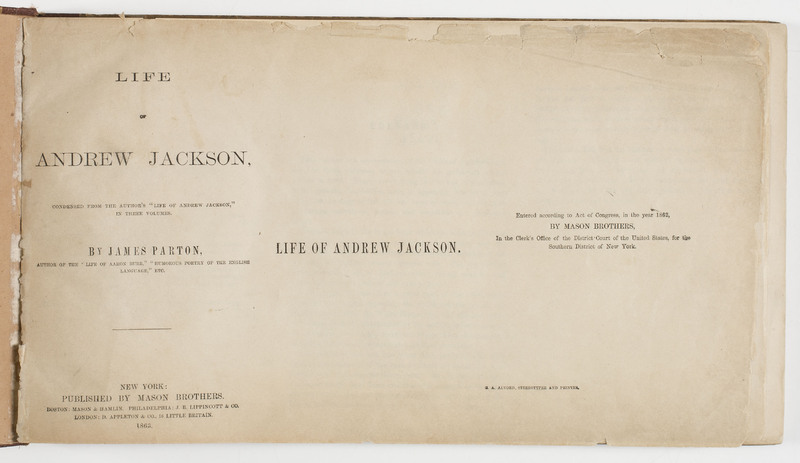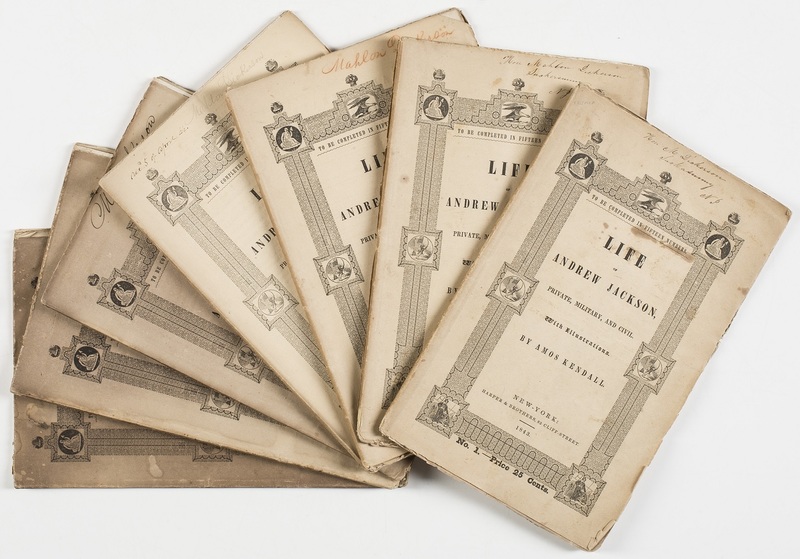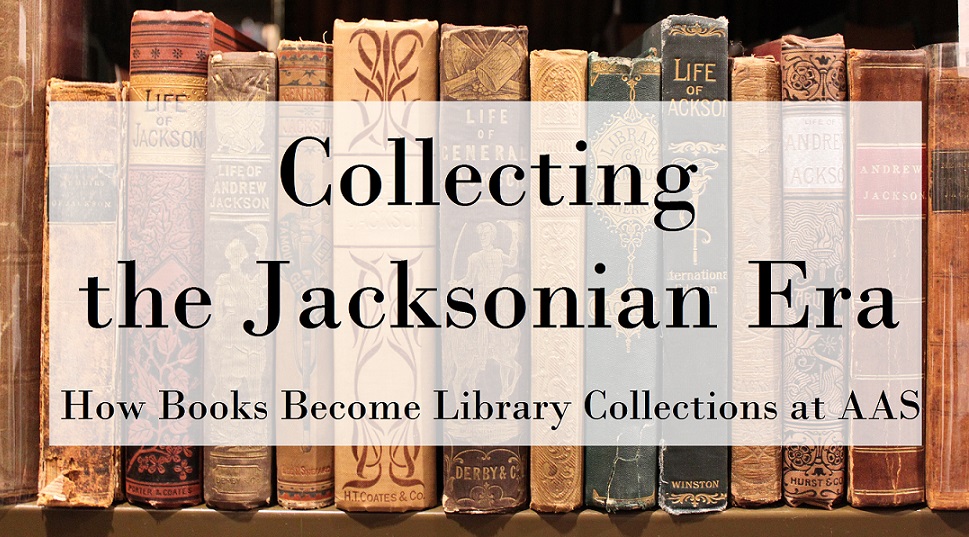Curate

Click here to discover why a curator would want this oddly formatted book, James Parton’s Life of Andrew Jackson, Condensed.

Click here for more about what can be learned from this Life of Andrew Jackson by Amos Kendall, an incomplete book that on p. 288 ends abruptly midsentence.
The goal in curating a collection is to build a group of items that speak to one another in intelligent and interesting ways. Their conversation together tells a story that would otherwise remain unheard.
Collection Development
Once it was decided AAS would acquire the William C. Cook Jacksonian Era Collection, decisions still had to be made regarding each specific item and how it might relate with or duplicate what was already in the Society’s library. Since the curatorial work at AAS is divided into five positions based on format—books/pamphlets, children’s literature, graphic arts, manuscripts, and newspapers/periodicals—all of AAS’s curators were involved with the William C. Cook Jacksonian Era Collection.
Individual curatorial acquisitions decisions are guided by the American Antiquarian Society’s collection development policy. The goal is to preserve at least one copy of everything printed before 1876 in North America, plus later materials and manuscripts on a more limited basis. Within these strict geographical and chronological bounds, the Society’s librarians and curators have always collected broadly, not knowing what will be of interest in the future. This approach has meant that time and again researchers have found at AAS precisely those primary sources essential for their research.
Limits
The Society’s omnivorous appetite for books and other materials is constrained by the limits of acquisitions budgets, library staffing, and physical storage space. Like any other collector, AAS curators must decide which items to acquire first, which subjects or genres to target, and when a second copy provides useful information or when it is merely redundant. Everything that ends up in a special collections research library has a cost associated with it, even the gifts. A wise curator counts that cost at the beginning.
When assessing potential new acquisitions, AAS staff must first determine if the Society already has this publication. Fortunately, most of the Society’s holdings have records in the online catalog but there are exceptions, especially among the books and graphic arts collections. Many potential acquisitions need to be double- or triple-checked against card catalogs and reference works such as the 754 green folio-sized volumes of the National Union Catalog, Pre-1956 Imprints (or N.U.C.) in the AAS reading room. Occasionally, curators must resort to trying to think like a nineteenth-century librarian and will check the shelf in the spot where they think their predecessor may have put that particular volume. This additional searching is fruitful often enough that it is a necessary part of an AAS curator’s repertoire. Even if a title is already at AAS, a second or even third copy may be acquired for its binding, annotations, or because it is a variant edition (see the example of the Washington, D.C., directory in the sidebar).
Selection Criteria
Curators do not have to go it alone in the decision-making process. AAS has a collection development committee consisting of the five curators, the head of acquisitions, and the Society’s librarian. The group meets monthly to assess the current state of the acquisitions budget, to talk through difficult decisions, or to consult regarding large purchases. Individual curators have discretion to make acquisitions decisions for their own collections, including spending the endowed funds that are allocated annually to each department. As a sign of just how congenial this group is at AAS, on occasion curators will even chip in money from their own acquisitions budget to support a significant purchase another curator cannot afford but must have. Such items are sometimes described as something that “just screams AAS”—but how does a curator know when an item belongs in the Society’s library?
-
Research value is the top selection criteria. A book becomes even more attractive if it can be used by more than one type of researcher—one may be interested in its binding, another in the extra illustrations, a third in its depiction of Native Americans. Part of the curator’s assessment of an item’s research value must include whether the content is available elsewhere. Bibliographic mysteries and incomplete publications (such as those described in the sidebar) are of particular interest as AAS is known for providing context for these types of difficult publications that are often not preserved or described well elsewhere.
-
Fit with other collections is another important factor in deciding whether to acquire an item. Though each curator advocates strongly for his or her own collections, the library’s collections as a whole are always of paramount importance. Each collection is made stronger by its connections to the others, so an item that relates to multiple collections, especially across curatorial departments, is a high priority.
-
Uniqueness will move a book right to the top of the acquisitions list. The appeal of a previously unrecorded imprint of which there are no other copies known is obvious. A book can also be made unique by being physically modified after it was purchased, as in the case of the extra-illustrated Life.
-
Comprehensiveness, while on the other end of the collecting criteria spectrum from uniqueness, is in many ways just as important at an institution that strives to have the collection of record for early American imprints. New knowledge can be gleaned from a mass of material that was invisible when looking only at one exemplar. Differences between copy 1 and copy 2 (or even copy 3 and copy 4) can give important publishing history clues. They may indicate different editions, issues, and states, stop-press corrections, cancels, or variant publisher’s bindings. Hence having multiple copies of the same edition can be incredibly useful for advancing scholarship. (More about this in the section on cataloging.)
-
Representativeness (if the Society has nothing else on a subject or form of printing technology that relates to the primary collections) and completing the story (rather than arbitrarily stopping a narrative of a person or technology at a chronological or geographic limit) are two reasons curators may acquire a book slightly beyond AAS's limited scope of pre-1877 North American imprints.
When a book first arrives at AAS, it is essentially there on probation or “on approval” until the curatorial decision-making process is completed. Once a curator determines a book is a good fit for AAS then the work of physically integrating it with the Society’s other collections begins, starting with acquiring and accessioning.
